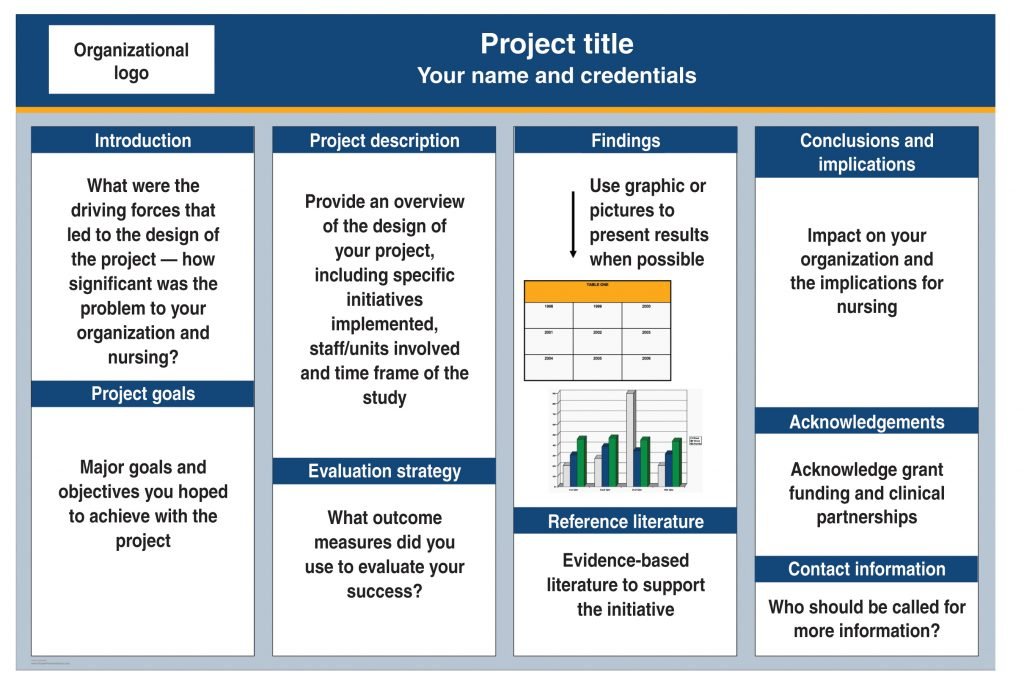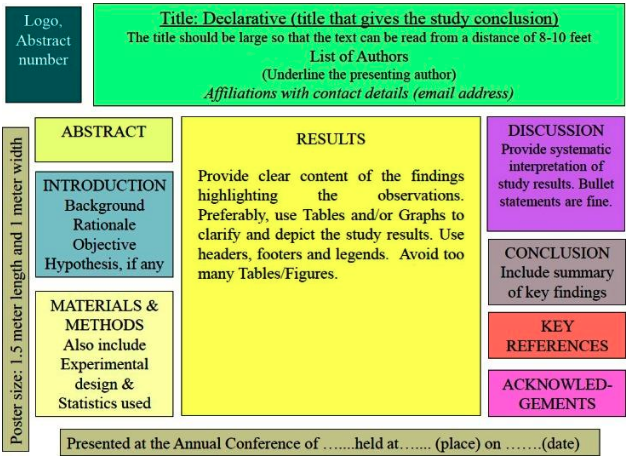Posters are part and parcel of scientific programs. And in the nursing community, posters are an extension of your research paper. It enhances your study, adding to your argument with visual cues.
Creating a poster is not the same as writing a paper, though. Both are entirely different medium and must be treated so. Lucky for you, I have a detailed guide on how to develop a poster template for your next nursing presentation. Check it out below:
1} Elements of a nursing poster
The content of the nursing poster may vary as per the topic, but the basic layout is the same. There are certain elements common to all posters, irrespective of the field of study. This section will list down these fundamental features in detail.
Before we begin, let me make a few things clear. Posters are not as lengthy or detailed as a research paper. Instead, they are concise and creative. However, this doesn’t mean that you don’t follow the prevalent academic standards.
The language used in the poster must always be in the third person. Also, always keep an objective approach towards the topic. This prevents the risk of discrepancies in your sign.
2} Purpose
Start the poster with a short para discussing the topic and your area of study in brief. Mention the reasons for designing the poster and the central themes discussed in your paper.
Nursing posters simplify the scientific narrative. Anyone can understand the data presented simply by looking at the charts and graphs. It is an effective way to present the key points of your research appealingly.
Posters also give you the space to add new details and annotations that couldn’t be included in your paper. They are a great addition to medical conferences, seminars, and workshops.
3} Visual appeal
Every poster is a mix of visual and text-based content. You can use different coloured backgrounds, images, charts, and graphs to present your argument. On the other hand, the poster also contains elements like a hypothesis and problem statement
Infographics give the viewer a better idea about the subject. You can include a lot of information without compromising on the visibility of the poster. Visual cues have a universal appeal.
You don’t need technical expertise to decode a graph and gather insights from it. Add a reference chart and a short para to explain the plan, and you’re set.
4} Arrangement
The trick to a good poster lies in its arrangement. Good content is useful only when you arrange it properly. The core message of the poster should be clear at a glance. This is why I suggest my students prioritize their content
Summarize the key points and make it the central theme of your poster. Include only information that adds value to your research. Some posters also contain multiple slides, each explaining a particular aspect of the topic.
Follow the standard content arrangement of a beginning middle and an ending. Keep the intro short and to the point. Also, stick to the conventional fonts styling options, i.e. Times New Roman or Arial, size 12.
Ace your presentation with our nursing poster template
5} Template construction
Earlier, posters were hand-made and quite meticulous. Today we have applications to add, edit and customize signs anyway we want. You can create posters on PowerPoint, Adobe platforms or simple MS Paint.
Students can even draw inspiration from the online poster templates. You can even consult your teachers about what to include in the poster. Don’t try to copy every aspect of the template though. Improvise on the design and add a personal touch to your poster.
First-timers can refer to this source for some ideas on how to format their template. Presented by Vanderbilt school of nursing, it is a valid platform to get you started. A standard poster contains the following.
a. Title
Consider the title slide to be the USP for your poster. It is what draws the reader in and compels them to browse through your research. The title slide aims to educate and intrigue the viewer.
Ensure that you include all the relevant keywords in the title. In the age of online academic presentations, this improves your visibility and appeal immensely. The name gives our crucial details about the nature of your research.
You can add a short abstract after the title slide as well. These elements give the reader some context about your work.
Plus, it answers primary questions about the purpose and contribution of your research in the nursing coursework.
b. Introduction
The introduction should be 200 words or less. Use this space to define the core issue of your topic. Nursing posters can be about a myriad of topics. Medical breakthroughs, standard healthcare practices or awareness about disease prevention are some common areas you can explore.
Students prefer to include their hypothesis and problem statement along with the introduction. A hypothesis is a logical construct used to prove or disprove your argument in the paper.
c. Research methodology
The research methodology refers to the tools and resources used for your paper/poster. Everyone has a separate approach to the topic at hand. For instance, a poster about COIVID-19 pandemic can talk about precautionary methods, standard practices, and new cures.
The methods and material you incorporate in your research define your perspective. You can focus on any particular aspect of the topic and expand upon it. This is the section where you add the charts and tables to prove your point.
Consider the methodology as the main body of the poster. Use this section to outline your statistical plan. What do you want to show? What are your core focus areas? How do you plan to accomplish it? These are a few questions to address here.
d. Results
Once you have addressed the questions, its time to find some answers. Analyze the graphs and charts to locate recurring patterns in your study. This is a slightly descriptive section where you explain the stats and what they convey.
Devote a paragraph or two to the analysis section. I even suggest that you summarize the results in bullet points. Bullet points are easier to read and hold a certain aesthetic appeal as well.
e. In-depth analysis
I suggest you do go astray with the analysis. Keep this section limited to a para or two, not extending 200-250 words. Devote an entire slide to this section, so that you get maximum space to convey your points.
Repeat the hypothesis and use it to solidify your stance. Discuss how the poster enhances the research. Also, list the pros and cons of your paper. Use this space to address any criticism or questions that the reader may have.
Ace your presentation with our nursing poster template
f. Conclusion
The in-depth analysis is soon followed by a short conclusion where you tie all the loose threads together. Note that it is not mandatory to have a definitive ending to your research. Most advanced-level nursing posters have open-ended conclusions.
The last paragraph or section also discusses the scope of your research. It sheds more light on how your nursing poster benefits the healthcare system. Here you can also add a few lines to remind the reader about the central issue of your paper.
Keep the conclusion limited to a few sentences, followed by a citation and a short note of acknowledgement.
6} Citations and references
Every nursing poster has about 10-12 citations towards the very end. Here you list down all the books, journals and scholars who helped you with the research. Citations protect you from accusations of plagiarism.
For nursing posters, I usually prefer my students to use APA or Harvard style referencing. Check out citation generators online to get instant and accurate information on books and journals. CiteFast is a dependable tool that I know of. You can also refer to the university referencing guides for more details on the same. Ensure that this section doesn’t extend a few lines and comes right at the end of your poster design.
7} Need for poster making
Nursing posters are an essential part of your curriculum. This medium helps students holistically outline their research. Also, with the infographics, you can intrigue the reader and put your points across in a clear way.
With a poster, you have the added advantage of a visual appeal. Don’t try to cram in a lot of details, leave the in-depth analysis for your paper. Include information that is unique yet relevant to your research.
You can refer to these quick links to find some good nursing poster templates. I have curated these layouts from reliable university websites. You can draw ins1piration from them and also cite them in your bibliography.
APA style referencing guide: APA citation guide by Mendeley
Harvard referencing guide: Harvard referencing guide by Mendeley
Nursing poster templates: Poster Templates by Vanderbilt School of Nursing
Nursing poster regulations: The Anatomy of a Great Poster, SGIM Conference
8} The bottom line
Nursing posters would help students even in the professional sphere. They are useful in medical conferences, seminars, and training workshops. Pick from any of the online templates mentioned above and get started!
A well-made nursing poster works wonders in getting you that perfect grade. I hope this guide helps you design a creative poster for your next presentation. All the best!
Ace your presentation with our nursing poster template




 WhatsApp Us
WhatsApp Us